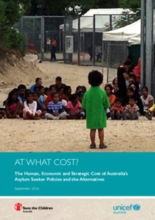Displaying 351 - 360 of 526
Organizations working to protect the health and wellbeing of children in emergencies are moving away from traditional paper-based systems towards more sophisticated and innovative digitally-based systems. Formative research was conducted to identify the state of the current evidence base on the use of information and communication technology (ICT) for child protection case management in emergencies (CPCME).
This report by Save the Children Australia and UNICEF Australia explores the human, economic and strategic cost of Australia’s current policies which seek to deter asylum seekers from migrating to Australia by sea.
In this video, Newsy discusses UNICEF's recent report that there are now 50 million displaced children worldwide.
In Sierra Leone, as in conflict and postconflict settings around the world, youth are coping with their exposure to violence during conflict as well as the poverty and displacement that follow war and the stigma that can persist long after involvement with armed groups has ended.
This paper from Best Start (a global campaign for Early Childhood Development led by children’s charity Theirworld) emphasizes the need for holistic early childhood development (ECD) programs - Safe Spaces - for young children in emergency situations.
This article from the Guardian sets forth the challanges EU countries face in providing social services for asylum seeking children.
This article discusses the major population displacement that unfolded in Africa’s Lake Chad Basin.
An estimated 50 million children are on the move in the world today. Millions more have been deeply affected by migration. The need for solid evidence to develop better policies on child migration has never been greater.
This study identifies risk factors for voluntarily joining armed groups, as well as to test association of conscription status and mental health.
This country care review includes the care-related Concluding Observations adopted by the Committee on the Rights of the Child.





